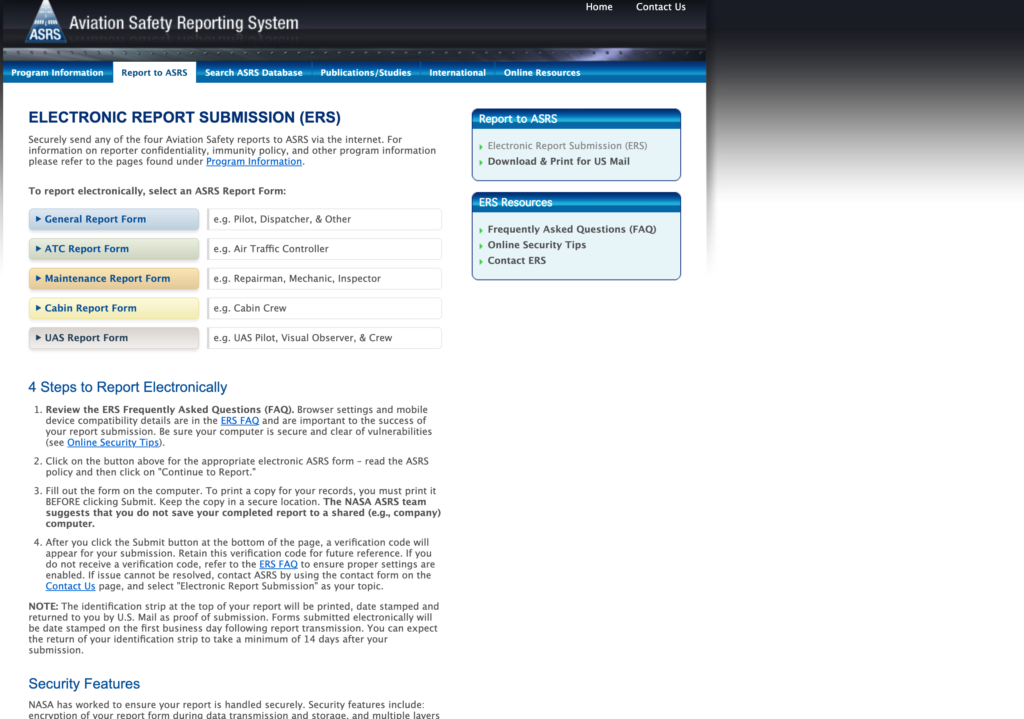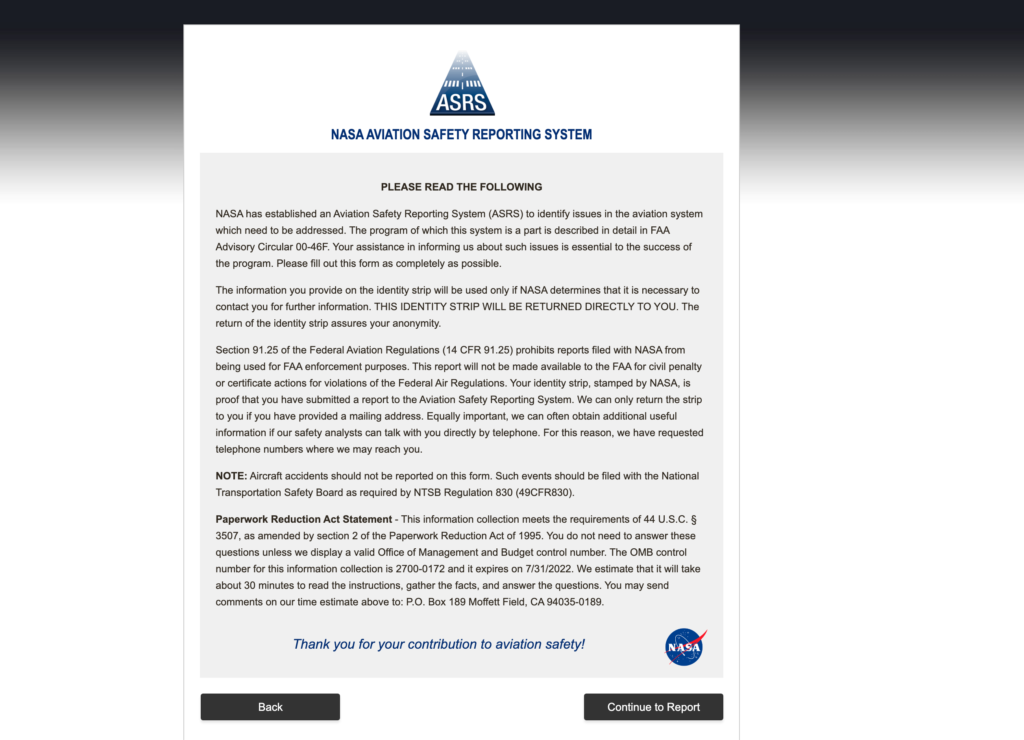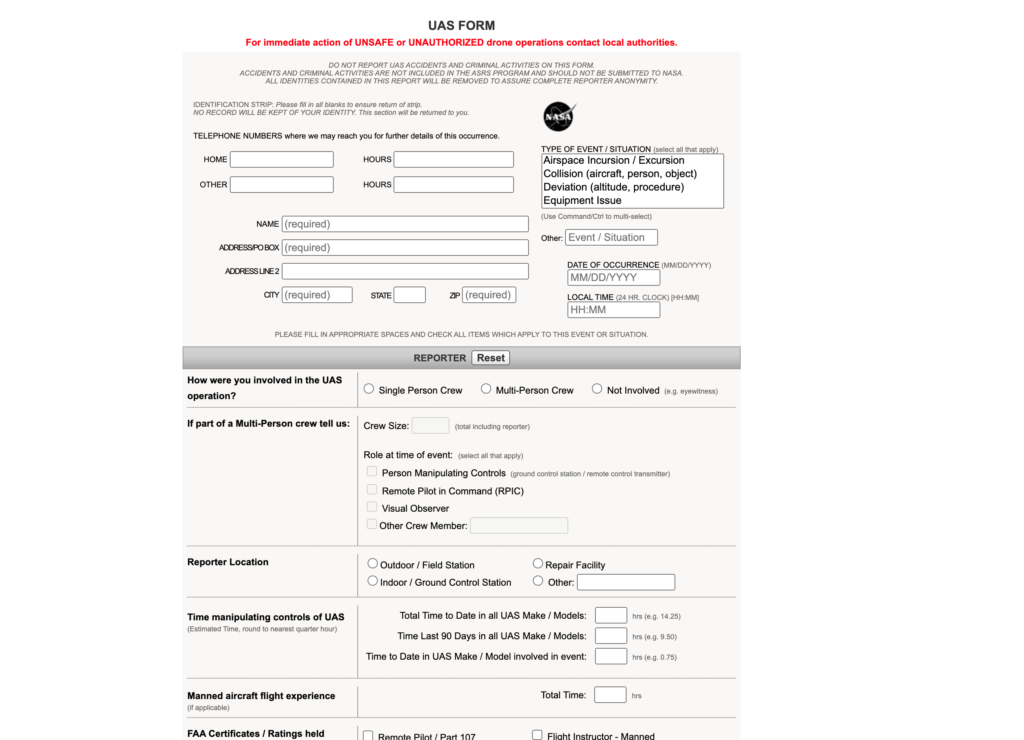When in doubt, fill it out! Contribute to the manned and uncrewed aviation safety culture.
Here at Aloft, improving the culture of safety and compliance in the drone industry is always at the forefront of our minds. That’s why today, we’re letting you know about NASA’s Aviation Safety Reporting System (ASRS) program, now available for reporting UAS safety incidents. ASRS has been a part of the manned aviation safety culture for over 45 years and has collected and analyzed over 1.7 million safety reports to date. These reports describe unsafe occurrences, hazardous situations, and lessons- learned to help prevent others from making the same mistake. The FAA has extended the Aviation Safety Reporting Program (ASRP) to UAS operators, including the protections offered through National Aeronautics and Space Administration’s (NASA) Aviation Safety Reporting System (ASRS). NASA’s ASRS UAS reporting form allows lessons to be shared with other UAS operators to prevent accidents and help make uncrewed operations safer. The FAA offers protection against civil penalty and certificate suspension in exchange for valuable safety information. Now let’s take a closer look at how the ASRS program works.
How does the ASRS work?
ASRS captures confidential reports, analyzes the resulting aviation safety data, and disseminates vital information to the aviation community. This system is completely confidential, voluntary, and non-punitive. UAS pilots in command, visual observers, payload operators, bystanders, and others involved in UAS operations can submit reports to the ASRS when they are involved in, or observe, an incident or situation in which aviation safety may have been compromised. All submissions are voluntary. If you file a report with NASA’s ASRS, the FAA considers this to be evidence of a constructive attitude. Therefore, even if a finding of a violation is made, a civil penalty or certificate suspension will not be imposed as long as:
-
– The violation was inadvertent and not deliberate;
-
– The violation did not involve a criminal offense, accident, or action under 49 U.S.C. § 44709, which discloses a lack of qualification or competency, which is wholly excluded from this policy;
-
– The person has not been found in any prior FAA enforcement action to have committed a violation of 49 U.S.C. subtitle VII, or any regulation promulgated there for a period of 5 years prior to the date of occurrence; and
-
– The person proves that, within 10 days after the violation, or date when the person became aware or should have been aware of the violation, he or she completed and delivered or mailed a written report of the incident or occurrence to NASA.
How to Electronically Submit to a UAS Report to the Aviation Safety Reporting System
1. Navigate to https://asrs.arc.nasa.gov/report/electronic.html in your browser, then click the ‘UAS Report Form’ button.

2. Read the information on this page and then click ‘Continue to Report’.

3. Now, fill the form out with all the information pertinent to the incident you are reporting.

Tips for Filling Out the UAS Reporting Form in the ASRS Properly
1. First, you will need to fill out your personal information. Remember, the ASRS program is 100% anonymous for the submitter. Reports sent to the ASRS are held in strict confidence. More than one million reports have been submitted to date and no reporter’s identity has ever been breached by the ASRS. ASRS de-identifies reports before entering them into the incident database. All personal and organizational names are removed. Dates, times, and related information, which could be used to infer an identity, are either generalized or eliminated.
2. The next section of the form asks the reporter to explain in as much detail as possible what the environmental conditions were when the incident occurred.
3. Next, describe the type of UAS(s) which were involved in the event.
4.The final section, asks for you to provide a description of the location, contributing factors, type of contributing factors, and a detailed written description of the event itself.
Once a report is submitted, the ASRS identifies system deficiencies, and issues alerting messages to persons in a position to correct them. It educates through its newsletter CALLBACK, its journal ASRS Directline and through its research studies. Its database is a public repository which serves the FAA and NASA’s needs and those of other organizations world-wide which are engaged in research and the promotion of safe flight.
The ASRS strengthens the foundation of aviation human factors safety research. This is particularly important since it is generally conceded that over two-thirds of all aviation accidents and incidents have their roots in human performance errors. As UAS operators, it is our responsibility to be an active participant in keeping the NAS safe for all aircraft, manned and uncrewed. Participating in ASRS as a UAS operator is a great way to do this. Education is key so if you observe a drone operation that may have been unsafe, reporting it through ASRS is a nonpunitive way to educate those involved for future, safer UAS operations. If you have further questions about using ASRS for UAS reporting, feel free to email us at team@aloft.ai or email NASA ASRS directly here. As always, fly safe and fly often!
Erica Cooley
Erica Cooley is Aloft’s Head of Community, she’s responsible for connecting with the expanding drone community to provide educational opportunities on how to leverage technology to fly with compliance and safety. Erica is an FAA-certified Part 107 Remote Pilot since 2017. Her passion for gender and diversity inclusion in the UAS industry is demonstrated as a proud member of Women and Drones & a brand ambassador for Women Who Drone. She is also an FAA Safety Team Representative in the Seattle, WA area. Erica received her BA from the University of Puget Sound in Communication Studies.



